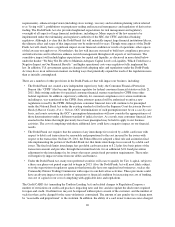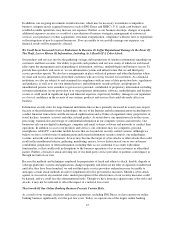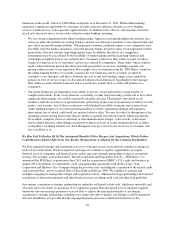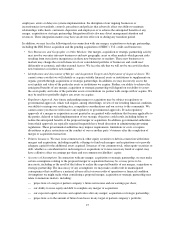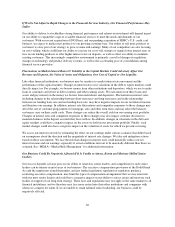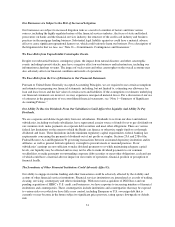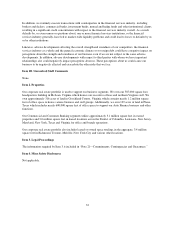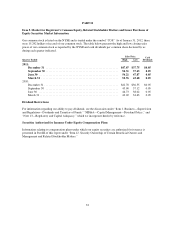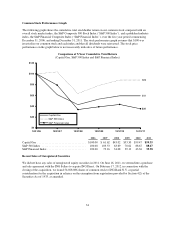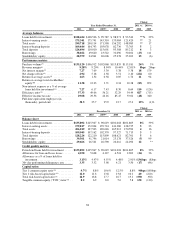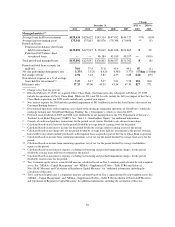Capital One 2011 Annual Report Download - page 50
Download and view the complete annual report
Please find page 50 of the 2011 Capital One annual report below. You can navigate through the pages in the report by either clicking on the pages listed below, or by using the keyword search tool below to find specific information within the annual report.If We Do Not Adjust to Rapid Changes in the Financial Services Industry, Our Financial Performance May
Suffer.
Our ability to deliver to stockholders strong financial performance and returns on investment will depend in part
on our ability to expand the scope of available financial services to meet the needs and demands of our
customers. With our recent acquisition of ING Direct and our pending acquisition of HSBC’s U.S. credit card
business, we expect to market new products to our growing customer base. Our ability to sell more products to
customers is a key part of our strategy to grow revenue and earnings. Many of our competitors are also focusing
on cross-selling, which could limit our ability to execute our cross-sell strategy or require lower interest rates or
fees on our lending products or offer higher interest rates on deposits, as well as affect our ability to maintain
existing customers. This increasingly competitive environment is primarily a result of changes in regulation,
changes in technology and product delivery systems, as well as the accelerating pace of consolidation among
financial service providers.
Fluctuations in Market Interest Rates Or Volatility in the Capital Markets Could Adversely Affect Our
Revenue and Expense, the Value of Assets and Obligations, Our Cost of Capital or Our Liquidity.
Like other financial institutions, our business may be sensitive to market interest rate movement and the
performance of the capital markets. Changes in interest rates or in valuations in the debt or equity markets could
directly impact us. For example, we borrow money from other institutions and depositors, which we use to make
loans to customers and invest in debt securities and other earning assets. We earn interest on these loans and
assets and pay interest on the money we borrow from institutions and depositors. Fluctuations in interest rates,
including changes in the relationship between short-term rates and long-term rates and in the relationship
between our funding basis rate and our lending basis rate, may have negative impacts on our net interest income
and therefore our earnings. In addition, interest rate fluctuations and competitor responses to those changes may
affect the rate of customer prepayments for mortgage, auto and other term loans and may affect the balances
customers carry on their credit cards. These changes can reduce the overall yield on our earning asset portfolio.
Changes in interest rates and competitor responses to these changes may also impact customer decisions to
maintain balances in the deposit accounts they have with us. In addition, changes in valuations in the debt and
equity markets could have a negative impact on the assets we hold in our investment portfolio. Finally, such
market changes could also have a negative impact on the valuation of assets for which we provide servicing.
We assess our interest rate risk by estimating the effect on our earnings under various scenarios that differ based
on assumptions about the direction and the magnitude of interest rate changes. We take risk mitigation actions
based on those assessments. We face the risk that changes in interest rates could materially reduce our net
interest income and our earnings, especially if actual conditions turn out to be materially different than those we
assumed. See “MD&A—Market Risk Management” for additional information.
Our Business Could Be Negatively Affected If It Is Unable to Attract, Retain and Motivate Skilled Senior
Leaders.
Our success depends, in large part, on our ability to retain key senior leaders, and competition for such senior
leaders can be intense in most areas of our business. The executive compensation provisions of the Dodd-Frank
Act and the regulations issued thereunder, and any further legislation, regulation or regulatory guidance
restricting executive compensation, may limit the types of compensation arrangements that we may enter into
with our most senior leaders and could have a negative impact on our ability to attract, retain and motivate such
leaders in support of our long-term strategy. These laws and regulations may not apply in the same manner to all
financial institutions, and we therefore may face more restrictions than other institutions and companies with
whom we compete for talent. If we are unable to retain talented senior leadership, our business could be
negatively affected.
30


